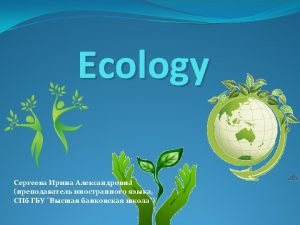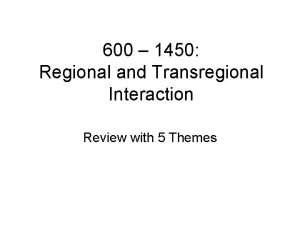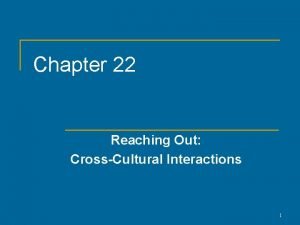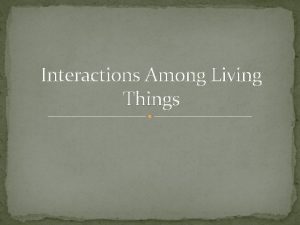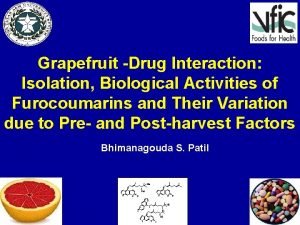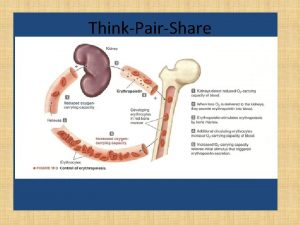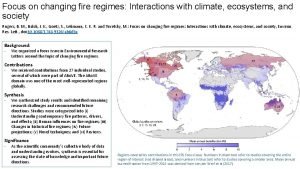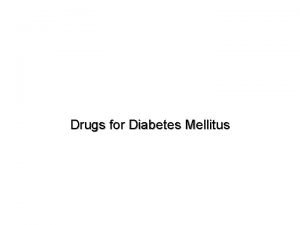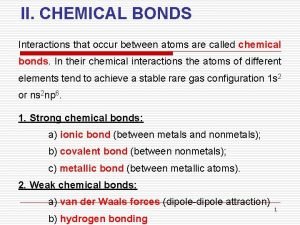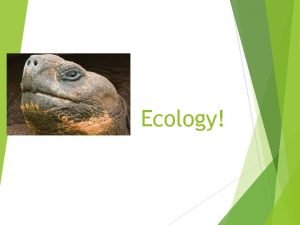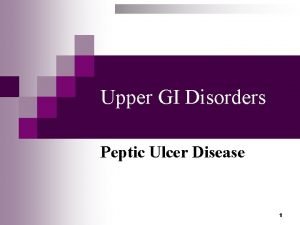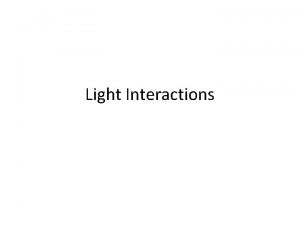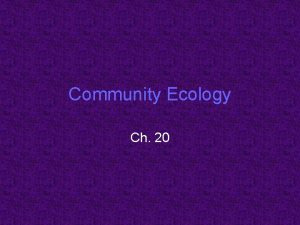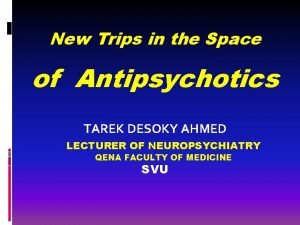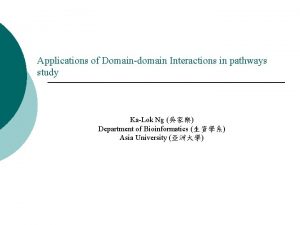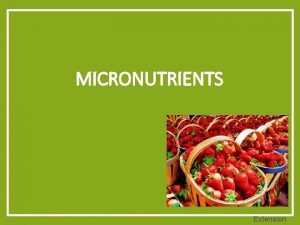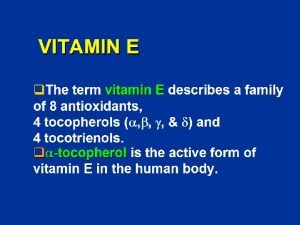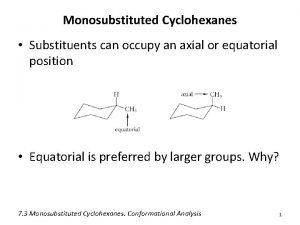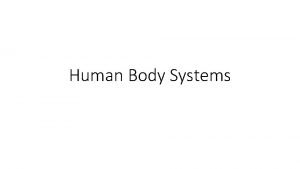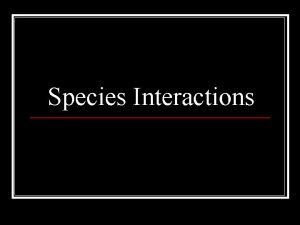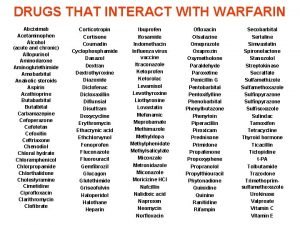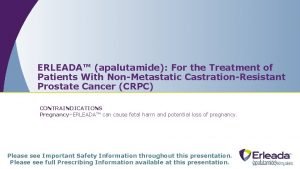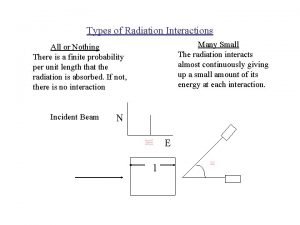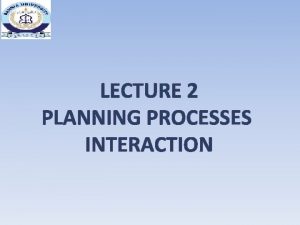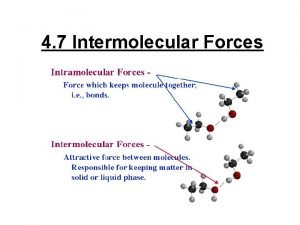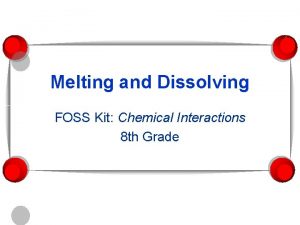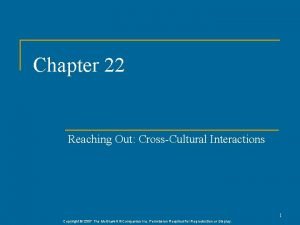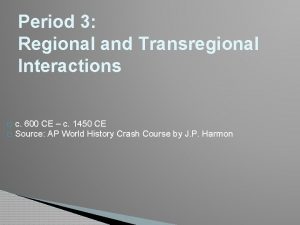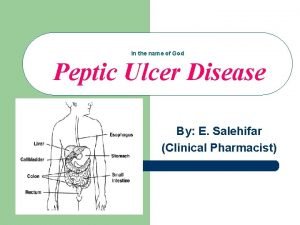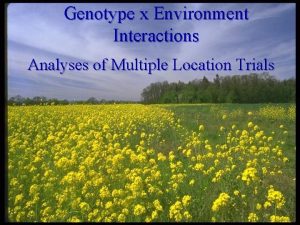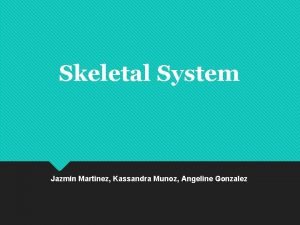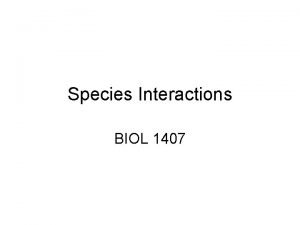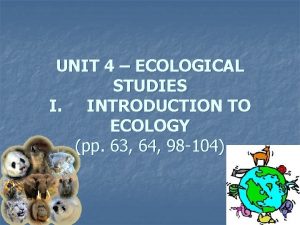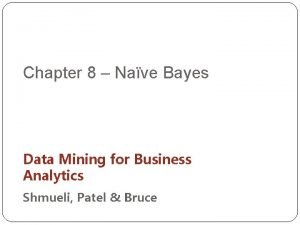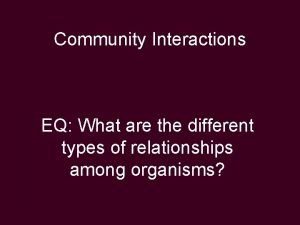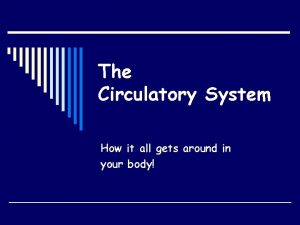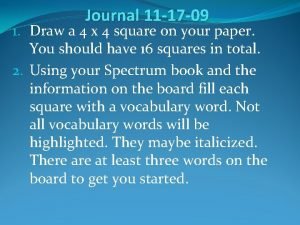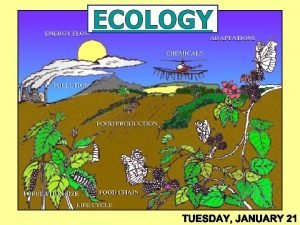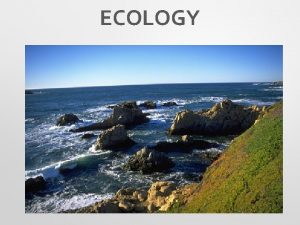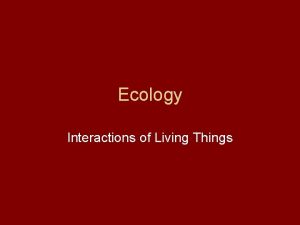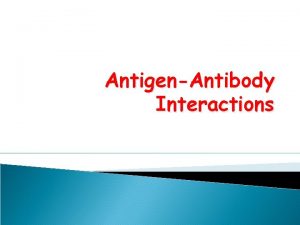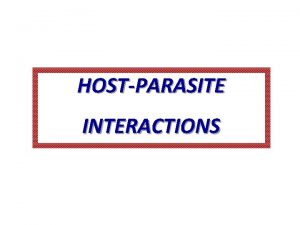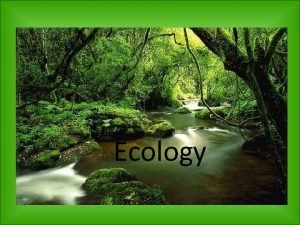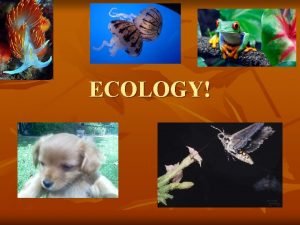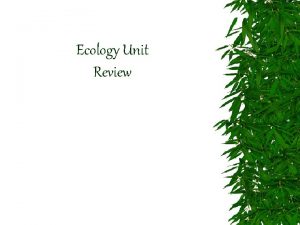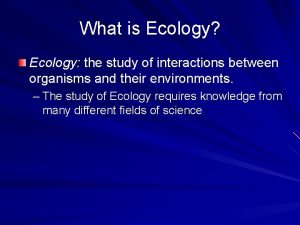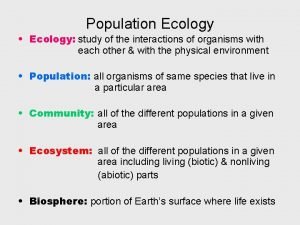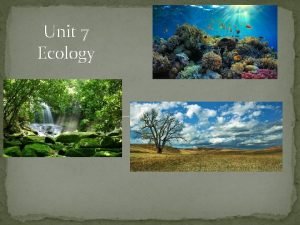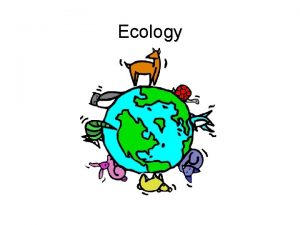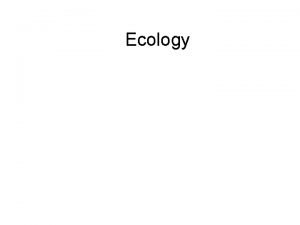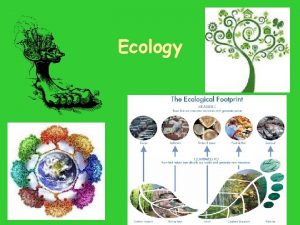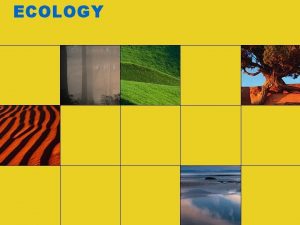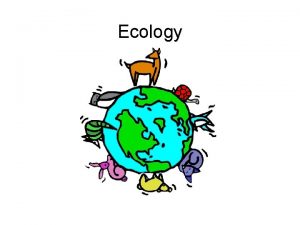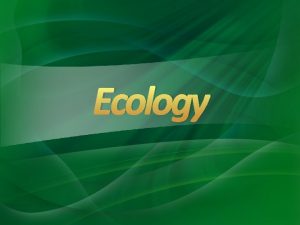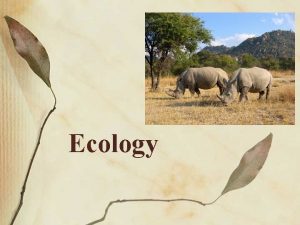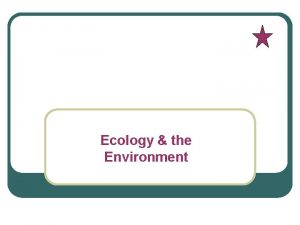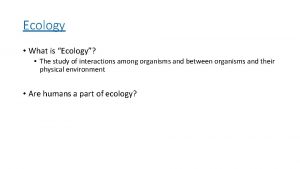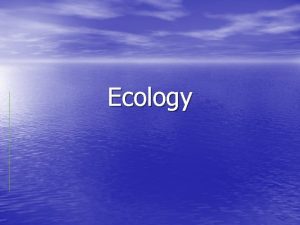Ecology Ecology Ecology the study of interactions of
































































































- Slides: 96

Ecology

Ecology • Ecology = the study of interactions of living organisms with one another and with their physical environment (soil, water, climate, etc. ) • Who? ecologists • 2 sets of environmental factors

Ecosystem Factors Biotic Factors = factors in an ecosystem that are living Examples: -Tree -Rabbit -Frog Abiotic Factors = factors in a ecosystem that are NONliving Examples: -Sun -Water -Weather -Fire

Levels of organization… can you remember? 1. 2. 3. 4. 5. 6. 7. 8. 9. 10. 11. 12. Atom Molecule Cell Tissue Organ system Organism Population Community Ecosystem Biome Biosphere

6 Levels of Ecology focus on organism biome 1. Organism = one individual 2. Population = 2+ of the same organism 3. Community = All types of living organisms in an area 4. Ecosystem = All living organisms AND nonliving factors in an area 5. Biome = group of similar ecosystems 6. Biosphere = all areas on earth where life exists

Habitat • Habitat = a place where a particular population lives

What might you find if you turn over a log? • Are all of these things competing for the same food? • Each population feeds in different ways, on different materials, and at different times this leads to reduced competition

Niche • Niche = all strategies and adaptations a species uses in its environment – How it meets its specific needs for food and shelter – How and where it survives – Where it reproduces Kind of like an organism’s “job”


Niche • All strategies and adaptations a species uses in its environment • How it meets: – its food needs – Its shelter needs – How and where it survives – Where it reproduces – Includes all interactions with biotic and abiotic factors

Quick Project… • Find 4 examples of Abiotic Factors – List pictures of EACH! • Find 4 examples of Biotic Factors – List pictures of EACH! • Define Abiotic Factor • Define Biotic Factor • Submit to FUSION when complete, but show Ms. C before submitting!

Abiotic Factors = nonliving things • • Soil and rocks Weather Water/rain temperature

Biotic Factors = Living things • • • Plants Fox You! Fungi Bacteria Protists

Interactions in Ecosystems • Competition • Predator/Prey • Symbiosis

What is competition? • Competition = when organisms compete or fight over a limited resource • Competition can be reduced by organisms having different niches in an ecosystem

Predator/Prey Interactions • Predator = organism that hunts other organisms for food • Prey = organisms that are hunted • Populations of directly impact each other!


Density Dependent Factors • Density Dependent Factors = factors in the ecosystem that can change as a result of the population density (# of organism in an area) • Examples: – Food – Shelter – Water – Disease

Not all interactions among organisms involve eating each other… • Symbiosis = organisms living together • 3 Types of symbiotic relationships – Mutualism – Commensalism – Parasitism

Mutualism • Mutualism = benefits both organisms in relationship

Commensalism • Commensalism = one organism benefits and the other is unaffected

Parasitism • Parasitism = one organism benefits and the other is harmed – PARASITES (like viruses) don’t immediately kill host… use it first – sometimes kill it later!


What do all living things need?

All living things must have energy in order to maintain homeostasis • Where does ALL energy orginate? • #1 source of energy = SUN • Energy flow is a “one way” street

Can you get energy from the sun? • What organisms can use the sun’s energy for food? – Autotrophs! • Autotroph = organisms that can make their own food (usually from sun or chemicals in environment) – Examples: plants, algae, photosynthetic bacteria, chemotrophs • AKA: producers

What are organisms called that can’t make their own food? • Heterotrophs = organisms that must “eat” their food to get energy • Examples: protists, fungi, animals, you! • AKA : consumers

How is the flow of energy shown? • Energy flow is shown with a food chain or food web.

Types of Heterotrophs • • • Herbivore Carnivore Omnivore Scavenger Decomposer

Herbivore • Herbivore = organism that only eats plants

Carnivore • Carnivore = organism that eats meat/other animals

Omnivore • Omnivore = organism that survives by eating both plants and animals

Scavengers • Scavenger = organisms that eat dead material

Decomposer • Decomposer = organisms that break down organic matter

How is the flow of energy shown? • Energy flow is shown with a food chain or food web.

Food Chain vs. Food Web • What do you think the difference(s) might be?

Food Chain

Food Web

Chemical Cycles

What are nutrients? • If nutrients are made of matter, can we create or destroy nutrients? • Matter (and nutrients) cannot be created nor destroyed!

Of what substance are all living things made? • Carbon… and other nutrients! • Nutrients = substances (elements/compounds) that are needed for life

How are nutrients cycled through ecosystems? • Nutrients cycle between living and nonliving factors in the environment • Matter is constantly recycled… never lost! • What kinds of nutrients/chemicals are cycled in ecosystems?

The Water Cycle

What is the water cycle? • Water cycle = the continuous movement of water from Earth’s surface to the atmosphere and back • What powers the water cycle? • Powered by the SUN which causes evaporation

Water Cycle Terms • Evaporation = water vapor (gas) in atmosphere • Condensation = water vapor in atmosphere water droplets (clouds) • Precipitation = condensed water falling from atmosphere to ground (rain, snow, sleet, hail)

The Water Cycle

Water Cycle Terms • Transpiration = water in plants (from ground) water vapor in atmosphere • Runoff = water on surface moving • Infiltration = water on surface soaking into soil/ground becoming groundwater

The Water Cycle

Human Impacts: Water Cycle • Water pollution • Deforestation can lead to increased erosion


What processes have we learned about that involve carbon? • Carbon Cycle = the movement of carbon from living things into the atmosphere and back • Involves: plants, animals, and atmosphere

Carbon Cycle • All living things are made of carbon • Where can you find carbon on earth? • How does it move/cycle around?

Carbon Cycle

Carbon Cycle Terms • Photosynthesis = carbon (CO 2) in air carbon in plants (glucose, C 6 H 12 O 6) + oxygen • Respiration = cells take in oxygen + glucose CO 2 + H 2 O • Eating = organisms use carbon in food to grow more cells in their own bodies


Carbon Cycle Terms • Atmospheric CO 2 = carbon dioxide in atmosphere (comes from fuel combustion, burning, respiration) • Dissolved CO 2 = carbon dioxide in bodies of water (comes from respiration of bacteria and fish)

Do fish “breath” water?

Carbon Cycle Terms • Fuel combustion = burning fossil fuels • Fossil fuels = hydrocarbons that form from life forms millions of years ago (petroleum, natural gas, oil shale, tar sands)


• Does all carbon cycle at the same rate? • What kind of carbon cycles faster? • What kind of carbon cycles slower?

Closed Carbon Cycle • Closed carbon cycle = carbon burned originated in atmosphere and can be replaced within a human lifetime • Example: burning wood, biofuel • Cellulose ethanol • Biodiesel • Wood chips • Torrification/gassification


Open Carbon Cycle • Open carbon cycle = carbon burned cannot be replaced within a human lifetime – Example: burning fossil fuels


• Even though the carbon is still being cycled, why does it make sense that this is called an “open” cycle?

Nitrogen Cycle • Where do you use nitrogen? • 78% of the air in the atmosphere is made up of nitrogen • Why do we have to give plants nitrogen in fertilizer? • Nitrogen must be converted to a USABLE form!

Nitrogen Cycle


Nitrogen Cycle Terms • Nitrogen fixer = plant that converts nitrogen from the atmosphere into nitrogen in the soil (usable form) for other plants to use • Urea = nitrogenous waste released from animals in urine; puts nitrogen back in soil

Phosphorous: Short Term or Long Term

Phosphorus Cycle: Short Term – Animals eat phosphorous animals die phosphorus returns to soil plants absorb phosphorous

Phosphorus Cycle: Long Term Phosphates are washed into water become sedimentary rock covered for millions of years rock is reexposed rock erodes phosphates are put back into ecosystem

Life in a community • How do plants and animals survive where they live? • Various combinations of abiotic and biotic factors interact around the world. • What does this mean about the different communities around the world?

Limiting Factor • Limiting Factor = any biotic or abiotic factor that restricts the existence, numbers, reproduction, or distribution of organisms • Examples: availability of water/food, predators, temperature

What is the limiting factor? Food Production in Saltbush (Altriplex) 16 Food production (mg of glucose) 14 12 10 Temperature and Food Production 8 6 4 2 0 0 5 10 15 20 25 Temperature (C) 30 35 40 Can you name the Independent variable? Dependent Variable? 45 50

Can factors indirectly affect populations? • Lack of rain prevents grass from producing seeds • Can this indirectly affect another population (other than just the grass? )

Ranges of tolerance • What does corn need to survive? • What if corn is grown in the shade… what will this do to the crop? • Tolerance = the ability of an organism to withstand fluctuations in biotic and abiotic environmental factors

Food production (mg of glucose) What is the range of tolerance? Food Production in Saltbush (Altriplex) 16 14 12 10 Temperatu re and Food Production 8 6 4 2 0 0 5 10 15 20 25 30 Temperature (C) 35 40 45 50


Succession: Changes Over Time • If you stopped cutting the grass in your front yard, what would happen? • In 1 year? • 5 years? • 90 years?

Succession • Ecological Succession = the orderly, natural changes and species replacements that take place in the communities of an ecosystem • Occurs in stages • Each stage has different plants and animals • Conditions of each stage are suitable for some organisms but not others

Succession • Can you observe succession? • Can take decades or even centuries to observe • 2 types of succession: – Primary succession – Secondary succession

Primary Succession • How are islands formed? • Do islands have dirt? • Primary succession = the colonization of barren land by communities of organisms • Land must have: No living organisms – Example: island forming/land after lava flow • Pioneer species = first species to take hold in an area – Example: lichen


Lichen on a rock

• What happens to the pioneer species (lichen, moss) over time? • Decaying lichen and sediment develop soil • Soil small plants • Small plants die more soil bigger plants • Over time the primary succession slows down and the community becomes stable

Ecological Succession

Climax Community • Climax community = stable, mature community that undergoes little or no change in species • May last for 100’s of years • *** If its stable, does it still change? *** • YES! • … but the changes are balanced!


Secondary Succession • What if there’s a fire that destroys a community? • What if a field isn’t replanted • What if a building is demolished and nothing is built on the site?

Secondary Succession • Secondary succession = the sequence of changes that takes place after an existing community is severely disrupted in some way • What are some possible disruptions? http: //www. youtube. com/watch? v=q. Ixy. Ucb 2 wq. I

Secondary Succession • What does secondary succession have that primary does not? • SOIL! • Will the species be the same? • Will secondary succession still reach climax community status? • Which will get there faster? (primary or secondary? )

This graph below represents primary and secondary succession over time. Notice that neither series is labeled for you… High Series 2 Species Biodiversity Series 1 Low Time -->

Which line represents primary succession? Secondary succession? Explain. High Series 2 Species Biodiversity Series 1 Low Time -->

Where is the climax community? High Series 2 Species Biodiversity Series 1 Low Time -->

What does the sudden drop in series 1 represent? High Series 2 Species Biodiversity Series 1 Low Time -->
 Biology ecology study guide answer key
Biology ecology study guide answer key Chapter 3, section 1: community ecology answer key
Chapter 3, section 1: community ecology answer key Ecology is the study that helps to preserve
Ecology is the study that helps to preserve Các môn thể thao bắt đầu bằng tiếng chạy
Các môn thể thao bắt đầu bằng tiếng chạy Tư thế ngồi viết
Tư thế ngồi viết Thẻ vin
Thẻ vin Hình ảnh bộ gõ cơ thể búng tay
Hình ảnh bộ gõ cơ thể búng tay Cái miệng xinh xinh thế chỉ nói điều hay thôi
Cái miệng xinh xinh thế chỉ nói điều hay thôi Mật thư anh em như thể tay chân
Mật thư anh em như thể tay chân Từ ngữ thể hiện lòng nhân hậu
Từ ngữ thể hiện lòng nhân hậu Trời xanh đây là của chúng ta thể thơ
Trời xanh đây là của chúng ta thể thơ Tư thế ngồi viết
Tư thế ngồi viết Ví dụ về giọng cùng tên
Ví dụ về giọng cùng tên Chó sói
Chó sói Thơ thất ngôn tứ tuyệt đường luật
Thơ thất ngôn tứ tuyệt đường luật Khi nào hổ mẹ dạy hổ con săn mồi
Khi nào hổ mẹ dạy hổ con săn mồi Thế nào là hệ số cao nhất
Thế nào là hệ số cao nhất Diễn thế sinh thái là
Diễn thế sinh thái là Vẽ hình chiếu vuông góc của vật thể sau
Vẽ hình chiếu vuông góc của vật thể sau 101012 bằng
101012 bằng Thế nào là mạng điện lắp đặt kiểu nổi
Thế nào là mạng điện lắp đặt kiểu nổi Lời thề hippocrates
Lời thề hippocrates Vẽ hình chiếu đứng bằng cạnh của vật thể
Vẽ hình chiếu đứng bằng cạnh của vật thể Tư thế worm breton là gì
Tư thế worm breton là gì đại từ thay thế
đại từ thay thế Quá trình desamine hóa có thể tạo ra
Quá trình desamine hóa có thể tạo ra Sự nuôi và dạy con của hổ
Sự nuôi và dạy con của hổ Các châu lục và đại dương trên thế giới
Các châu lục và đại dương trên thế giới Dạng đột biến một nhiễm là
Dạng đột biến một nhiễm là Nguyên nhân của sự mỏi cơ sinh 8
Nguyên nhân của sự mỏi cơ sinh 8 Bổ thể
Bổ thể Phản ứng thế ankan
Phản ứng thế ankan Thiếu nhi thế giới liên hoan
Thiếu nhi thế giới liên hoan Tia chieu sa te
Tia chieu sa te Hát lên người ơi
Hát lên người ơi điện thế nghỉ
điện thế nghỉ Một số thể thơ truyền thống
Một số thể thơ truyền thống Hệ hô hấp
Hệ hô hấp Cong thức tính động năng
Cong thức tính động năng Số nguyên tố là
Số nguyên tố là đặc điểm cơ thể của người tối cổ
đặc điểm cơ thể của người tối cổ Tỉ lệ cơ thể trẻ em
Tỉ lệ cơ thể trẻ em Các châu lục và đại dương trên thế giới
Các châu lục và đại dương trên thế giới ưu thế lai là gì
ưu thế lai là gì Regional and transregional interactions
Regional and transregional interactions Chapter 22 reaching out cross-cultural interactions
Chapter 22 reaching out cross-cultural interactions Examples of integral product architecture
Examples of integral product architecture Interactions among living things
Interactions among living things Grapefruit-drug interactions chart
Grapefruit-drug interactions chart Integumentary interactions with other systems
Integumentary interactions with other systems Interactions among branches of government
Interactions among branches of government Interactions
Interactions Interactions between ais and internal and external parties
Interactions between ais and internal and external parties Metformin overdose
Metformin overdose Interactions between atoms occur
Interactions between atoms occur Symbiosis and species interactions keystone webquest
Symbiosis and species interactions keystone webquest Moa of h2 antagonist
Moa of h2 antagonist Do all em waves travel at the speed of light
Do all em waves travel at the speed of light Section 20-1 review species interactions
Section 20-1 review species interactions Wave
Wave Sertraline interactions
Sertraline interactions Protein binding interactions
Protein binding interactions Nutrient interactions
Nutrient interactions Vitamin e drug interactions
Vitamin e drug interactions Gene interaction example
Gene interaction example Axial substituents
Axial substituents Nervous interactions with other systems
Nervous interactions with other systems Interactions within ecosystems grade 7
Interactions within ecosystems grade 7 5 major types of species interactions
5 major types of species interactions 5 types of symbiosis
5 types of symbiosis Sertaline
Sertaline Unit 5 ecology
Unit 5 ecology Pathway of food through digestive tract
Pathway of food through digestive tract Erleada mechanism of action
Erleada mechanism of action Types of interactions
Types of interactions Project management process interactions
Project management process interactions Flocabulary photosynthesis read and respond answers
Flocabulary photosynthesis read and respond answers Intermolecular force
Intermolecular force Type of mechanical waves
Type of mechanical waves Contractory monetary policy
Contractory monetary policy Foss chemical interactions
Foss chemical interactions Chapter 22 reaching out cross-cultural interactions
Chapter 22 reaching out cross-cultural interactions Integral product architecture
Integral product architecture Regional and transregional interactions
Regional and transregional interactions Ppi drug interactions
Ppi drug interactions Interactions
Interactions Skeletal interactions with other systems
Skeletal interactions with other systems Biotic
Biotic Joseph connell barnacle experiment
Joseph connell barnacle experiment Chapter 5 evolution and community ecology answer key
Chapter 5 evolution and community ecology answer key Commensalism in science definition
Commensalism in science definition Naive bayes pays attention to complex interactions and
Naive bayes pays attention to complex interactions and Parasitism
Parasitism Circulatory system interactions with other systems
Circulatory system interactions with other systems Wave interactions
Wave interactions Habitats niches and species interactions worksheet
Habitats niches and species interactions worksheet


